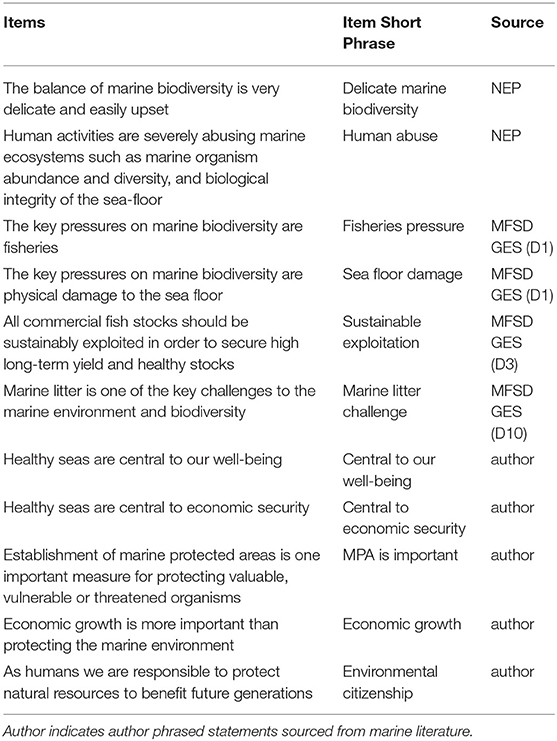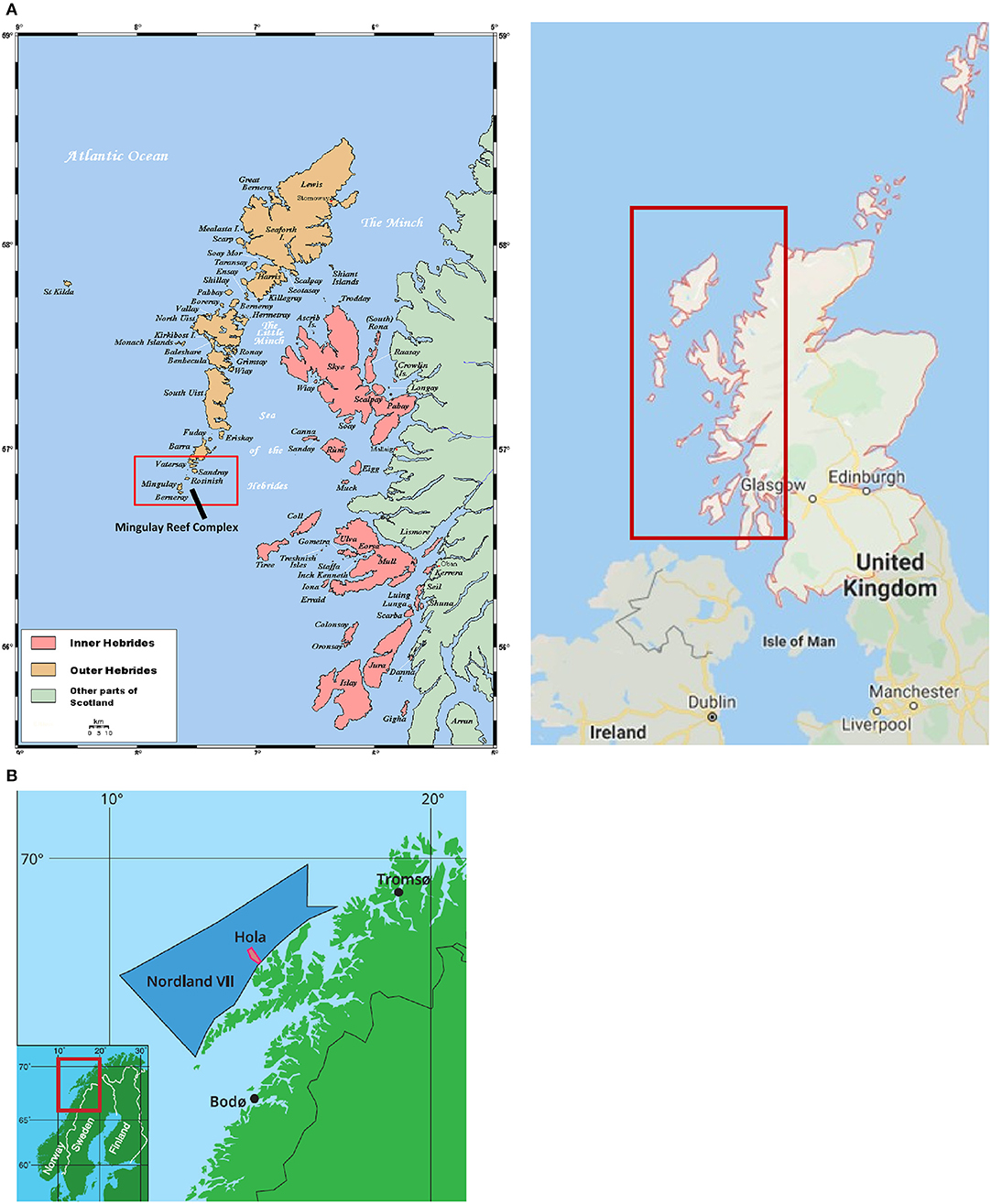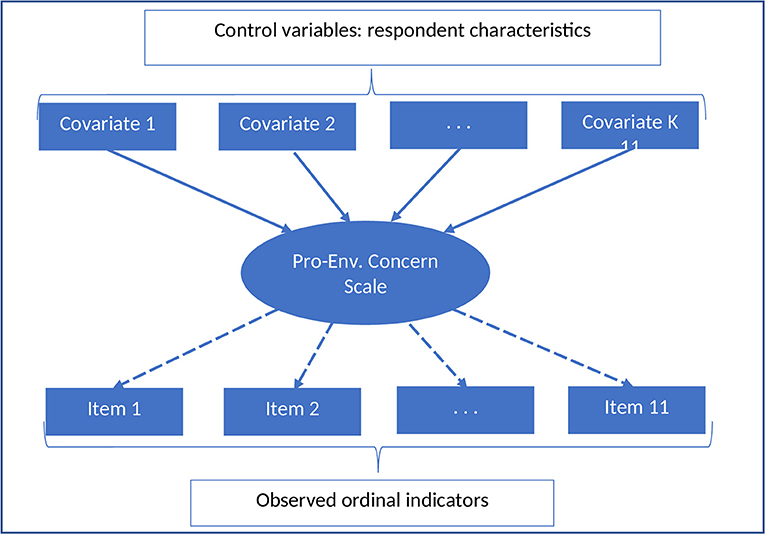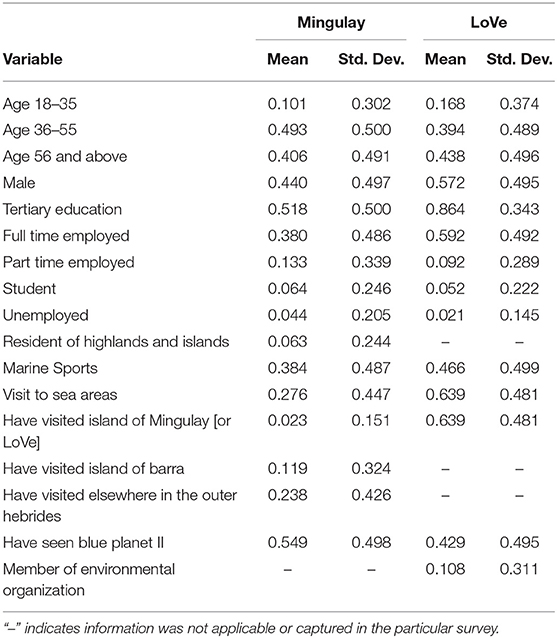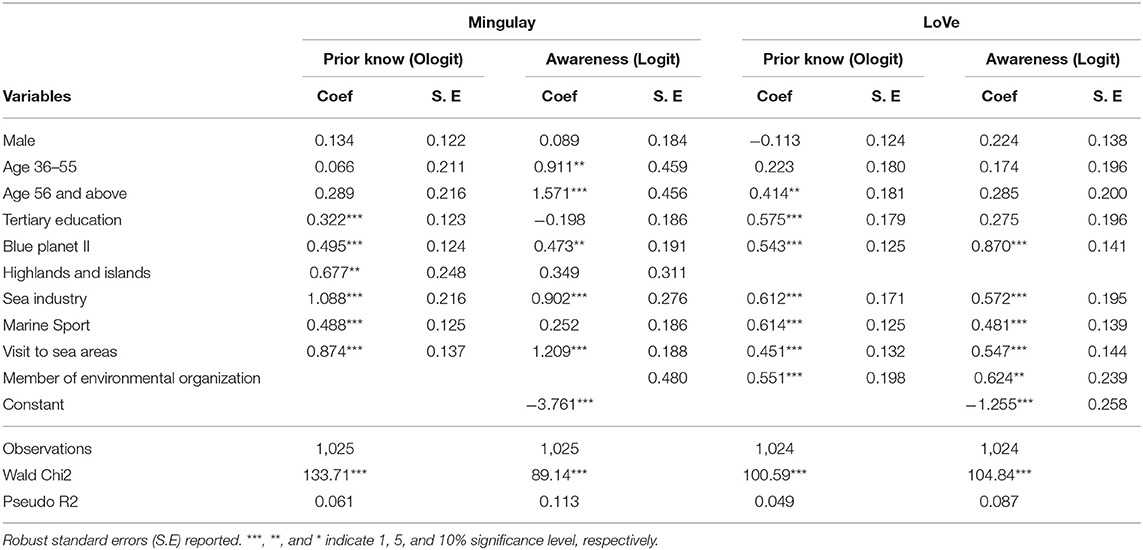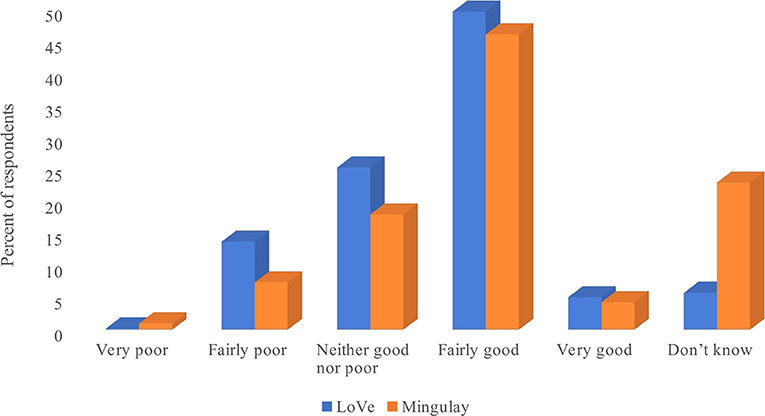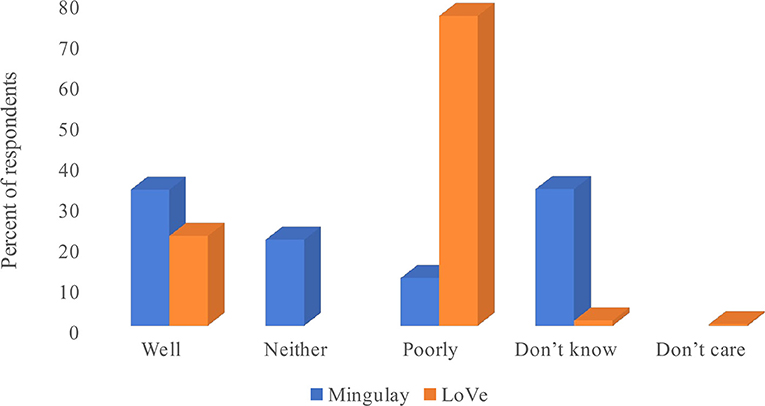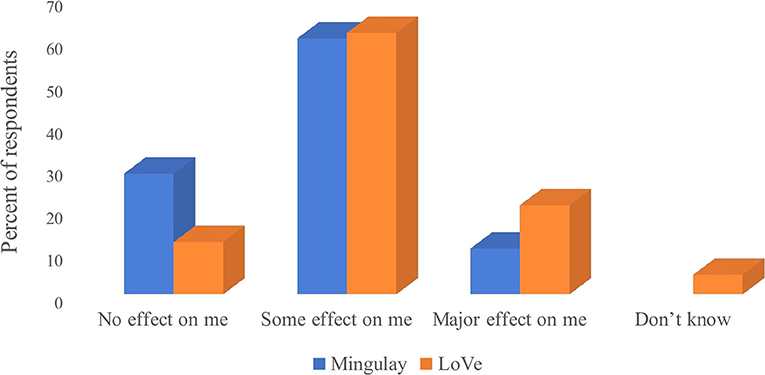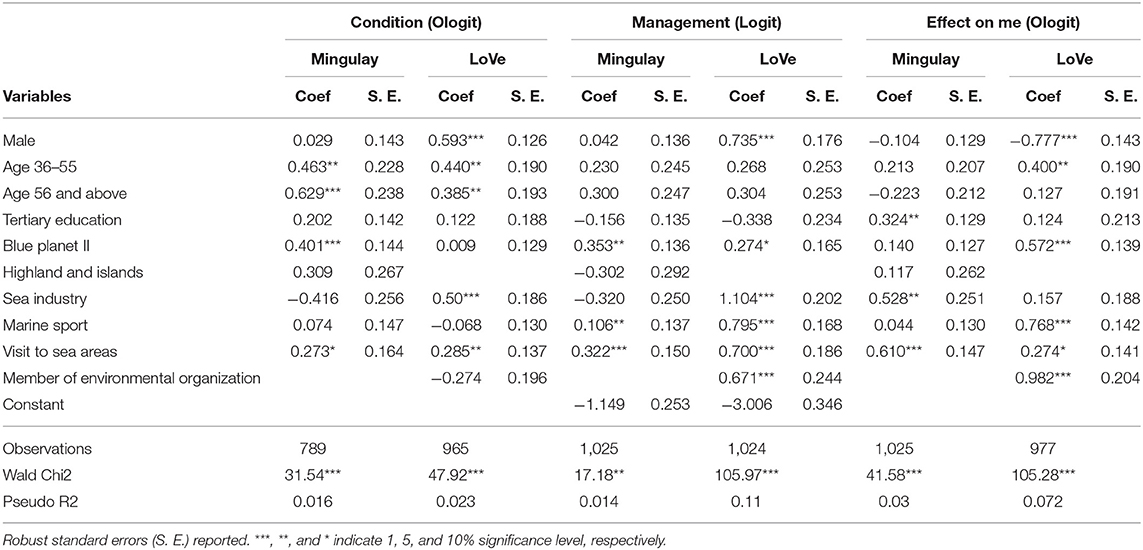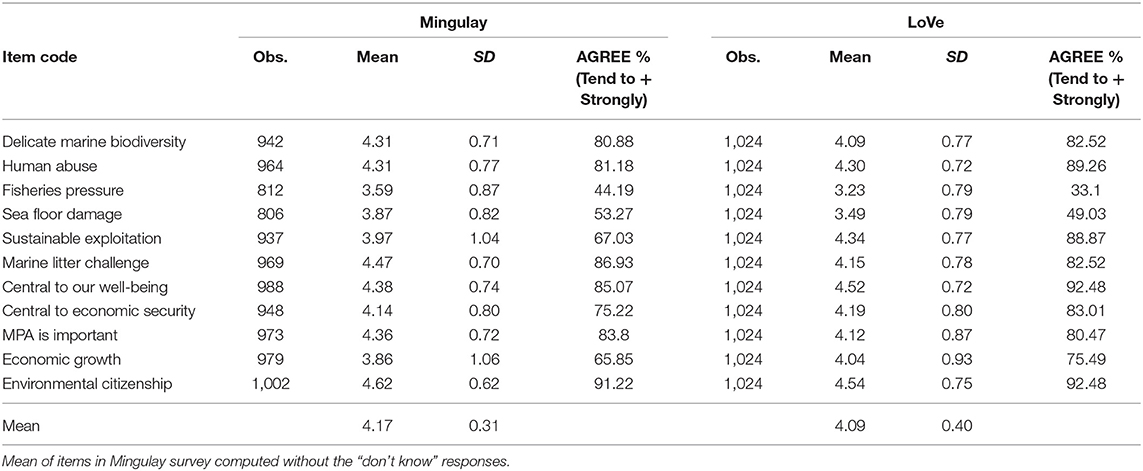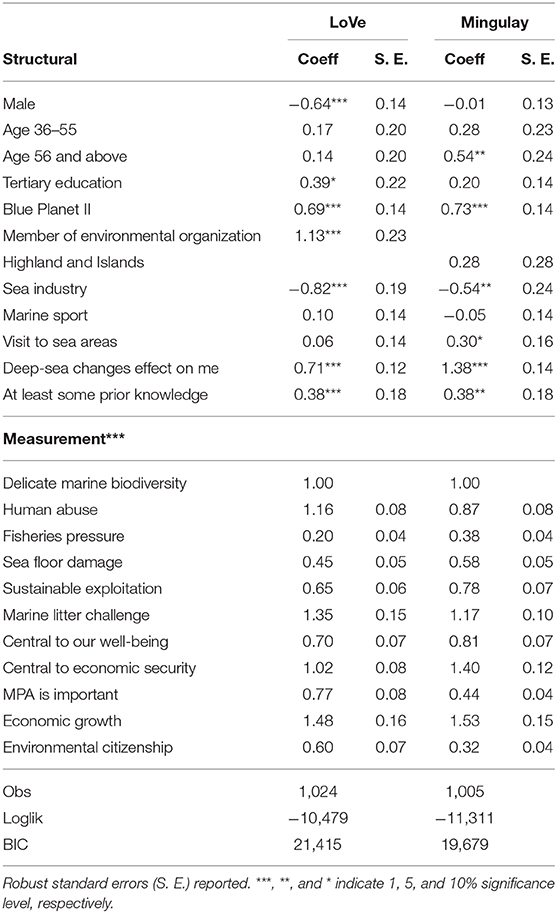- 1Socio-Economic Marine Research Unit (SEMRU), Whitaker Institute, National University of Ireland, Galway, Ireland
- 2Norwegian College of Fishery Science, UiT the Artic University of Norway, Tromsø, Norway
Knowledge of people's understanding of environmental problems is vital for the effective implementation of the ecosystem approach to marine management. This is especially relevant when conservation goals are aimed at ecosystems in the deep-sea that are remote to the consciousness of most people. This study explores public perceptions of the deep-sea environment among the Scottish and Norwegian public. It further analyses the relationships between respondents' pro-environmental concerns toward the marine environment and personal characteristics using a multiple indicators multiple causes model. The results show that public knowledge of the deep-sea environment is low for Scottish and moderate for Norwegians. Awareness of cold-water corals was high for the Lofoten case study area amongst the Norwegian public and low for the Mingulay reef complex in the Scottish case. These differences might arise because Norway is known to host the world's largest cold-water corals in the Lofoten area; a fact that has been well-publicized. We find that most people think changes in the deep-sea have at least some effect on them. On average, the public perceive the deep-sea condition to be at most “fairly good” but are dissatisfied with the management of it with approximately only one third or less thinking it is well-managed. Generally, the public perception from both countries show ecocentric attitudes toward the marine environment implying that they recognize the value of ecosystem services, the current ecological crisis and the need for sustainable management.
Introduction
Oceans provide vital ecosystem services that benefit humans (Armstrong et al., 2012). These include regulating services related to carbon sequestration, provisioning services such as food and energy as well a plethora of highly varied cultural services that provide value to mankind. Many of these services are threatened by pressures emanating from human activities (Barbier et al., 2014; Mengerink et al., 2014), questioning our understanding of the interaction between oceans and humans. It has been noted that the public's understanding of such interactions is limited, with ocean literacy substantially lagging behind more broad environmental literacy (Uyarra and Borja, 2016). Most ocean literacy studies are broad in scope (Fletcher et al., 2009) or mostly coastal in nature (Steel et al., 2005; Hynes et al., 2014), while deep-sea literacy is even less well-known (Rogers et al., 2014). In this work we therefore focus on deep-sea environments, more specifically cold-water corals, in order to ascertain the public's knowledge and perceptions regarding threats, potential, and management, in Norway and Scotland. Public knowledge and perceptions are important in order to ensure conservation measures which demand political decision-making. This is potentially extra demanding in relation to the deep-sea which is spatially and temporally distant to most people. With this in mind, this paper examines the public's knowledge and perceptions of the deep-sea in two maritime nations. Norway presents an interesting case study as it hosts the world's largest cold-water corals in the Lofoten area with continual pressure to open it for petroleum exploration. Scotland on the other hand, hosts the Mingulay Reef Complex (MRC), the only known inshore coral reef in UK waters. The reef supports high level of biodiversity.
Since the expansion in the exploration of deep-water environments using new technologies in the mid-1980s, new insights have been revealed about the largest biome on earth which has challenged conventional wisdom of the deep-sea (Mengerink et al., 2014). Cold-water corals were now found in dark, cold, nutrient rich-waters which lacked the symbiotic light-dependent algae that was a characteristic of the known tropical corals (Freiwald et al., 2004). They can live at depths of 40 to 2,000 m, in temperatures as low as 4°C. Lophelia pertusa is the most common habitat-forming, reef-building cold-water coral which has been the focus of deep-sea research since the recognition of their vast, world-wide extent two decades ago (Arnaud-Haond et al., 2017). L. pertusa have been shown to provide habitat, concentrate biomass and act as feeding and nursery grounds for many species, including those targeted by commercial fisheries (Arnaud-Haond et al., 2017). In the Scottish cold-water coral Mingulay reef complex for example, L. pertusa provides a complex three-dimensional habitat for many species including communities of suspension invertebrates such as sponges and other corals (Henry and Roberts, 2007; Henry et al., 2013; Douarin et al., 2014). According to Blanchard et al. (2014), the Lofoten area cold-water coral reefs in Norway have been characterized as having high ecological value and are considered a vulnerable marine ecosystem. The area constitutes spawning ground for Northeast Arctic cod and haddock and is a nursery for cod, herring, saithe, and haddock larvae.
Anthropogenic activities coupled with climatic changes pose a threat to the deep-sea and marine wildlife, including cold-water corals (Ramirez-Llodra et al., 2011). Climate change and mineral exploitation are of concern in terms of maintaining marine biodiversity (Armstrong et al., 2019). However, in the case of deep-sea cold-water corals, the greatest threat is destructive fishing practices, particularly bottom trawling (Puig et al., 2012; Pusceddu et al., 2014), given that corals are fragile and slow growing (Hall–Spencer et al., 2002). Moreover, pollution from marine litter presents one of the growing challenges (Newman et al., 2015). Recent discoveries have shown that despite the deep-sea and its resources being remote to the daily lives of most people, the adverse anthropogenic pollution effects are approaching sufficient severity to cause impacts in the deep-sea areas (Ryland, 2000; Cole et al., 2011; La Beur et al., 2019). Social media images of the deep sea, including the litter found there, are increasing public awareness of these impacts1. According to Pham et al. (2014), plastic is the most prevalent litter on the seafloor and litter from fishing activities (derelict lines and nets) is particularly common on sea mounts, banks, mounds, and ocean ridges.
With such pressures, the attention given to the deep-sea and its cold-water coral species from researchers and conservation activists has increased with a call for nations to protect deep-sea coral ecosystems (Barbier et al., 2014; Mengerink et al., 2014). One vital conservation strategy for deep-sea reefs is the designation of marine protected areas (MPAs) (Huvenne et al., 2016). Protection of deep-sea vulnerable marine ecosystems like cold-water coral reefs was initially a problem in the EU, as the EU Habitats and Birds Directives, the main legal tool for nature conservation in the EU, allowed Member States to set up two types of protected areas, namely the Special Areas of Conservation (SACs) for wildlife habitats and species and Special Protection Areas (SPAs) for birds, but only for terrestrial areas and territorial waters. By being only applicable to territorial waters of up to 12 miles from the coast, the directive thereby excluded further offshore cold-water coral reefs. A court ruling in 1999 permitted applying the directive to waters out to the 200 nm Exclusive Economic Zones (De Santo, 2013).
Consequently, deep-water MPAs, MPA networks, and SACs have been established around many cold-water corals (e.g., off Norway and Ireland, around the Azores, and many more places) to ban extraction of living and non-living resources that can invoke activities harmful to the corals (Armstrong and van den Hove, 2008; Armstrong et al., 2014; Huvenne et al., 2016). In Scotland, the MRC has been designated as a MPA (La Beur et al., 2019). In Norway, the Lofoten area was closed to fossil fuel extraction after intense political deliberation. However, there is continual pressure from lobby groups to open the area for petroleum exploration due to expected fossil fuel richness2. Marine conservation policies may therefore be essential to protect deep-sea resources in the area. However, as knowledge of deep-sea ecosystems is limited, success of protective measures could be marginal. Without significant understanding of the public awareness of the importance and vulnerability of these ecosystems, what additional information should be provided to the public in regard to marine conservation will be unknown, and potentially beneficial policies may not be implemented due to insufficient public support.
The implementation of protective measures such as MPAs naturally involves reallocation of resources and property rights (Hattam et al., 2014) which prohibits or reduces access to marine resource use. This invariably impacts communities which reside nearby and utilize those resources. As such, MPAs are often met with resistance from stakeholders who fear loss of their livelihoods and recreational opportunities and for whom little is known of their understanding of the marine ecosystems. Given this complex relationship between people and their environments, it is crucial to deal with conservation problems together with the beliefs, customs, attitudes, and practices of the relevant society (Gray et al., 2010; Hynes et al., 2018). Hence, the EU Marine Strategy Framework Directive (MSFD), which aims to achieve good environmental status for EU marine waters, proposes an ecosystem-based approach to marine management with humans at the center. Since society is made up of ordinary persons, the public perceptions and opinions on the use of marine resources and support for sustainable management is as important as the positions of organized stakeholder groups whose opinions are often captured through policy consultations in marine policy programs. This is because communities are made up of heterogeneous individuals (hereafter referred to as the public) whose collective choices related to the marine resource they use, the areas they visit or reside in, is what drives the many key pressures on the marine environment (Norton and Hynes, 2018).
Public Perceptions Of the Marine Environment In the Literature
Public perception research aimed at understanding stakeholder and resource users have come to matter in marine science given that societal behavior change has the potential to reduce pressures on marine systems (Jefferson et al., 2015) through production and consumption choices. Moreover, public engagement and acceptability as well as participatory governance drives conservation programs to restore and protect marine resources (McKinley and Fletcher, 2012; Voyer et al., 2012). As a result, knowledge of people's understanding of environmental issues is required for attaining conservation goals. In the context of this study, “perception” is used as an umbrella term following Jefferson et al. (2015) to include components such as knowledge, interest, social values, attitudes, or behaviors. Studies examining these components are extensive and either assess general marine environmental conditions or specific marine ecosystems, resources, or user groups using qualitative and quantitative approaches (see Trenouth et al., 2012; Hamilton and Safford, 2015; Daigle et al., 2016).
Empirical evidence shows that public perceptions are defined in varying contexts. The evidence also shows that there is considerable heterogeneity in perceptions which is influenced by socio-demographic profiles, behavioral attitudes, and beliefs. They further vary by the scope of marine components or activity and between nations. For instance, a review of various reports across European countries point toward considerable support for marine planning initiatives (Potts et al., 2016); a matching of public perception with scientific consensus regarding climate change impact on seas, but low awareness of certain climate change components such as ocean acidification. Marked differences were observed between countries. Generally, females and older people were found to be more concerned about the issues raised, while distance to the sea shaped perceptions toward the marine environment (Buckley et al., 2011).
In a recent questionnaire-based study by Lotze et al. (2018), 21 countries involving 32,000 respondents were compared from around the world to examine marine threats and protection. The authors showed that more than two-thirds believed the marine environment was under threat from human activities and the most severe threats were pollution, fishing, habitat alteration, and climate change. There was a general consensus toward major perceived threats and willingness to support conservation goals. Within national borders, Hynes et al. (2014) show that Irish people demonstrate reasonable knowledge of threats facing marine environments and of the market and non-market importance of marine ecosystem services. Skepticism does exist, however, among the public concerning the government and private industry ability to manage the marine economy, while there is more trust in scientists. In repeat surveys conducted in 2005, 2010, and 2015 by Hawkins et al. (2016) to evaluate awareness and attitudes toward marine protection in the United Kingdom, respondents showed pessimism, perceiving sea health, and management to be poor to fair and largely in decline, with about two-thirds of the respondents agreeing that more than 40% of UK seas should be protected from fishing and other damaging activities.
Rose et al. (2008) show that much of the marine environment and conservation research relates to coastal areas, except those studies concerned with a relatively small number of specific creatures such as whales or focused on fishing and pollution issues. The authors then show in a survey of about 3,000 respondents in the UK that <1% of the population could name a topographic or living element of a real deep-sea landscape. About 44% thought the deep-sea was generally, utterly or mostly barren in their region and often talked about the coast when asked about the sea.
Jefferson et al. (2014) assess public perceptions toward UK subtidal species and marine health to determine positive connections between society and the sea. Many respondents showed interest in traditionally charismatic species but lacked knowledge of their existence in UK seas. Pollution from marine litter was considered the greatest indicator of marine health but lacked consensus that the presence of megafauna was an indicator. In exploring sources of heterogeneity in perceptions, the authors identified gender and experience as key influencers on public perceptions of species. Perceptions of marine health was on the other hand found to be influenced by social values.
Against the backdrop of the emerging importance of public perceptions research of the deep-sea (Jefferson et al., 2015) and the sparse literature of what people know and feel about the deep-sea, the current study contributes with public perception of the deep-sea environment in Norway and Scotland. It further disentangles influencing factors using a multiple indicators multiple causes model, to aid public engagement and policy formulation toward the achievement of good environmental status of Europe's marine environment.
Methods
Participants
The survey was conducted to collect data on the people of Scotland (hereafter Mingulay, indicating the deep-sea areas of the MRC) and Norway (hereafter LoVe, indicating the Lofoten-Vesterålen coral reefs) and is used to analyze their perceptions of the marine environment and deep-sea areas. Following a pilot test of the survey questions, the questionnaire was implemented online through market research companies who drew from recruited and registered online panels of respondents. The recruitment of respondents was in accordance with EU standards in terms of research code of conduct and data protection bylaws. Participants had the option to decide whether to take part in the survey or not. The Mingulay survey started in January 2019 and spanned over a period of 4 weeks while the LoVe survey started in March 2019 and lasted over a period of 3 weeks. A total of 1,025 and 1,024 respondents participated in the Mingulay and LoVe surveys, respectively, and the demographic profiles are presented in Table 1. In both surveys, young adults were the least represented. The age group 55+ years were the most represented (44%) in the LoVe survey while the 36–55 years group were the most represented (49%) in the Mingulay survey. Males constituted 44 and 57% of respondents for Mingulay and LoVe, respectively. Gender is slightly skewed from the respective national population ratios of ~50%. While about half of the Mingulay respondents had tertiary education, ~86% of LoVe respondents were in the same category.
Survey Design
Participants were asked questions about their knowledge, perceptions and attitudes toward the Scottish and Norwegian seas and wildlife, as well as the Lofoten-Vesterålen cold-water coral reef in Norway and the Mingulay reef complex in Scotland3. The locations of these deep-sea ecosystems of MRC and LoVe are shown in Figures 1A,B, respectively, below.
Prior to answering the questions, participants were informed about the background to the survey. Information provided included the impact of changing environmental conditions and anthropogenic activities on the seas and wildlife, how the government was responsible for managing it and the potential cost of management on households. The MRC and LoVe were then introduced in each survey as a unique ecosystem in Scotland and Norway, respectively, and the ecosystem services they provide, current management measures in place, potential economic benefits and threats were presented.
The first part of the questionnaire assessed respondents' prior knowledge of the information provided in the introduction of the questionnaire on the deep-seas and wildlife in the respective countries using a scale of 1 to 5 where 1 indicates “I knew none of it” and 5 indicates “I knew everything.” Prior awareness of the MRC and LoVe were assessed through a Yes/No response. Respondents' perception of the condition of the deep-sea areas were rated on a scale of 1 (indicating very poor) to 5 (indicating very good), personal effect of the deep-sea and wildlife was rated as “no effect on me,” “some effect on me,” and “major effect on me” while perceived management of the deep-sea areas rating was scored as “well,” “neither,” and “poorly.” “Don't know” was given as an option in all scores.
The second part of the survey captured information including any visits to marine areas, participation in marine related activities, and exposure to the BBC's Blue Planet II documentary. Respondents pro-environmental concerns and beliefs in relation to the marine environment were also evaluated on an 11-item 5-point Likert scale ranging from “strongly disagree” to “strongly agree,” with a don't know option. The 11 items covered areas including ecological crisis, pressures, conservation, and ecosystem services. The items were an adaptation of 2 sentences (first two) from the New Ecological Paradigm (NEP) scale (Dunlap et al., 2000) and 9 author self-constructed sentences from the European Union Marine Strategy Framework Directive (MSFD) qualitative descriptors for good environmental status (GES) and other literature sources. It therefore reveals the convergence between public perception and the EU Directive on what good environmental status for the marine environment should be. For subsequent analysis, the scores of item 10 (Economic growth is more important than protecting the marine environment) are reversed to match the other indicators so that higher overall scores reflect ecocentrism (nature-centered values of the environment) while lower values indicate anthropocentrism (human-centered values of the environment).
Analytical Approach
The data were analyzed using basic statistical summaries, charts and cross tabulations. Where necessary, the Pearson Chi-square test was used to test for statistical independence across samples and variables. Basic regression models including logistic and ordinal logistic regressions were employed to evaluate the relationship between respondent characteristics and outcome variables of interest due to the ordinal and binary nature of the outcome variables.
Regarding the analysis of relationships between respondents' pro-environmental concerns toward the marine environment and personal characteristics, generalized structural equation modeling (GSEM) is employed. The GSEM can accommodate large numbers of endogenous and exogenous variables and build models that include latent variables as well as response variables that are not continuous measures. In this study, the Multiple Indicators Multiple Causes (MIMIC) model is used based on a generalized structural equation model founded on the following conceptual model (Figure 2).
In the MIMIC model, it is assumed that the observed indicators (y) are manifestations of a latent concept (unobserved pro-environmental concern, η) and that there are other exogenous variables x (with covariates 1 to S) that influence the latent factor (Jöreskog and Goldberger, 1975; Rabe-Hesketh et al., 2004). In the dataset, we captured the pro-environmental concern items as discrete indicators which are generalized responses of a categorical (ordinal) nature. Therefore, the generalized structural equation model (GSEM) is employed as opposed to structural equation models which assume continuous indicator responses. The GSEM formulation of MIMIC consists of the simultaneous estimation of two equations. The measurement model for pro-environmental concern can be written in terms of the underlying continuous responses
and the structural equation is written as
with the reduced form
where y* is the latent component for y, β, and ∧y are the corresponding structural parameters relating the latent dependent variable to the covariates, and factor loading matrix, respectively. π = β ∧y′ are vector of parameters to be estimated. v is a vector of respondent disturbance, u is a random error term assumed to be standard logistic, and u is the reduced form error composed of u=∧yv+e. To achieve model identification, typically the first factor loading is restricted to unity.
With respect to the measurement equation, j(j = 1, 2, …, J) and τj denote agreement levels and thresholds associated with these agreement levels, respectively. These unknown thresholds are assumed to partition the propensity into J−1 intervals. The unobservable latent variable y* is related to the observed ordinal variable y by the τ with a response mechanism of the form:
To ensure well-defined intervals and natural ordering of observed agreement levels, the thresholds are assumed to be ascending in order, such that τ0 < τ1 < … < τJ where τ0 = −∞ and τJ = + ∞.
Results
A summary statistic of the survey respondents' attitudes is presented together with the socio-economic profiles in Table 2. As shown, only 6% of the Scottish respondents are residents of the Highlands and Islands. A significantly higher fraction of Norwegian respondents was engaged in marine sports (47%) as compared to the Scottish respondents (38%). In terms of visits to the sea areas, only about 2% of Scottish respondents have specifically visited the MRC, and 28% have visited the sea areas around Scotland including the island of Barra and elsewhere in the Outer Hebrides. Comparatively, 64% of the respondents in the Norwegian sample had visited Lofoten-Vesterålen.
Knowledge and Awareness of Deep-Sea Areas
Figure 3A below presents the distribution of prior knowledge levels of the information presented in the introduction section of both the Mingulay and LoVe surveys. The LoVe responses appear symmetric while Mingulay is positively skewed with respective mean (standard deviation) scores of 3.13 (0.88) and 1.75 (0.78) and a median score of 3 and 2. This reflects that on average, the majority of the Norwegian respondents perceived themselves more knowledgeable of the deep-seas and wildlife within their marine environment than did the Scots. However, the average perceived prior knowledge levels were low with Scottish respondents lying close to “I knew little of it” while Norwegians were close to “I knew some of it.” A Pearson Chi-square test of independence of distribution of responses between the two samples was x2(4) = 883 (pvalue = 0.00). This indicates that independence is rejected and hence confirms that Norwegians had higher prior perceived knowledge than their Scottish counterparts. The standard deviation estimates relative to the mean also shows higher variation in perceived knowledge levels for the Norwegian respondents (Coefficient of Variation, CoV = 50%) than the Scottish (CoV = 25%).

Figure 3. (A) Prior knowledge of the deep-sea and wildlife information. (B) Awareness of cold-water coral reefs.
In terms of awareness represented in Figure 3B below, the Mingulay survey shows only 16% of Scottish respondents were aware of the MRC while a significantly higher share (59%) of the Norwegian respondents were aware of the cold-water coral reefs at Lofoten-Vesterålen. In general, we conclude that knowledge levels related to the deep-sea environment is low among the Scottish and moderate among Norwegians, but the latter with high variance.
Given the ordinal and binary nature of responses to prior knowledge and awareness, we use ordered and binary logistic regressions to evaluate how responses differ across respondents. The results are shown in Table 3 below. On prior knowledge, we do not identify any significant differences between gender and age in the Mingulay survey. However, the senior-aged group in the LoVe survey appear to have more perceived prior knowledge of their seas and wildlife. Variables including tertiary education, having watched the Blue Planet II deep-sea documentary, association with a sea related industry, engagement in marine sports and those who had visited the sea areas were more likely to have high perceived prior knowledge given the statistical significance at the 1% level. Moreover, living in the region of the Highland and Islands (in the case of Scottish respondents) and being a member of an environmental organization (in the case of Norwegians) have significant positive effect on perceived prior knowledge.
In regard to awareness, no significant differences exist for gender and having a tertiary education in either country. However, the age cohorts 36–55 and 56 and above were more likely to be aware of the MRC while age had no significant effect on the awareness of the Lofoten-Vesterålen cold-water coral reefs. Having watched Blue Planet II, being associated with a sea industry or having visited the sea areas previously all have significantly positive effect on awareness. Marine sport participation has a significantly positive impact on awareness of the Lofoten-Vesterålen cold-water coral reef as does being a member of an environmental organization. No significant differences existed among those living in the region of the Highlands and Islands.
Public Perceptions of the Deep-Sea Condition, Management, and Personal Effect
Respondents' rating of the deep-sea condition, management and whether they perceive changes in the deep-sea to have an effect on them were assessed with the distribution of responses presented in Figures 4–6. Perceptions of the deep-sea condition shows a similar distribution for both Mingulay and LoVe surveys where most respondents rated it to be “fairly good” with respective fractions of 46 and 50%. The mean (standard deviation) rating for LoVe was 3.5 (0.81) and Mingulay was 3.6 (0.81) which are relatively similar. A Pearson Chi-square test of independence rejects the null: x2(5) = 145 (pvalue = 0.00) and shows that the odds (odds ratio = 1.3, excluding the “don't know” group) of Scottish respondents rating the deep-sea to be in good condition is higher than for the Norwegian respondents.
With the ordinal nature of the deep-sea condition responses, an ordinal logistic regression shows that males were more likely to rate the deep-sea condition higher in the LoVe survey, whereas no significant differences existed for Mingulay. For both surveys, the age group >35 years perceived the deep-sea condition to be good as opposed to the age cohort 18–35 years. However, slightly higher odds were observed for age 56 and above in Scotland and age 35–55 in Norway. Moreover, the Blue Planet II effect was significant and positively impacted the Mingulay perceived rating of deep-sea condition, though not for LoVe. On the other hand, association with a sea-industry and visits to the sea-shore had a significant effect on the LoVe perceived deep-sea condition rating.
With the perceived rating of deep-sea management outcomes shown in Figure 5, we observed 34 and 22% of respondents rating the deep-sea as being well-managed for Mingulay and LoVe respondents, respectively, while 12 and 76% rated it poorly. Moreover, Figure 5 shows zero observed frequencies for the “neither” and “don't care” responses in the LoVe and Mingulay surveys, respectively. For ease of comparison, we evaluated the differences in responses to be binary (1/0) outcomes where 1 indicates “well-managed” and 0 otherwise.
A logistic regression of perceived deep-sea management (shown in Table 4) indicates significant variations occurred between those who had watched the Blue Planet II documentary and those who visited the sea-areas in the Mingulay survey. These relationships were significantly positive. Regarding the LoVe survey, perceived better management of the deep-sea was significantly positive at the 1% significance level for males, as was association with a sea-industry, participation in a marine sport, a visit to the sea areas and being a member of an environmental organization.
Regarding respondents' perception of whether changes in the deep-sea has “personal effect on them,” Figure 6 shows that for both Mingulay and LoVe surveys, most respondents perceive it has “some effect” on them, with shares of 61 and 62%, respectively. A Pearson Chi-square statistic of: x2(3) = 147 (pvalue = 0.00) reveals that the test of independence is rejected and an odds ratio of 0.40 for Mingulay shows that Norwegian respondents perceive changes in the deep-sea to have a larger effect on them than their Scottish counterparts. This is reflected in the mean (standard deviation) rating scores of 1.82 (0.60) for Mingulay and 2.09 (0.59) for LoVe. The Mingulay regression analysis shows that only those with tertiary education, an association with a sea-industry or those whom have visited the sea areas, significantly influence “effect on me” positively at the 1% significance level. For the LoVe survey, respondents experiencing personal effects were more likely to be females, were 36–55 years, watched the Blue-Planet II documentary, engaged in marine sports and were members of an environmental organization.
Pro-environmental Concerns Toward the Marine Environment
The public's concern in relation to the marine environment was captured by 11 item indicators and reflect statements toward ecological crisis, pressures on the marine environment, ecosystem service benefits and the need to protect it through sustainable management. The concerns were captured on a 5-point Likert scale where higher overall scores designate ecocentrism and lower scores indicate anthropocentrism. The distribution of responses is shown in Table 5. The mean itemized score ranges from 3.59 to 4.62 with an overall mean of 4.17 for the Mingulay survey. The range for LoVe is 3.23–4.52 with an overall mean of 4.09. This reflects that on average the public tend to agree with the statements indicating a direction toward ecocentrism.
For the Mingulay survey, the highest mean score is linked to agreement with the statement that humans are responsible for protecting natural resources to benefit future generations. The highest fraction, 91% either tend to, or strongly, agree with this statement. The same statement scores highest in the LoVe survey with 93% agreeing. The statement “marine litter is one of the key challenges to marine environment and biodiversity” has the second highest mean score for Mingulay and fourth in the LoVe survey. For both surveys, the least agreed upon is the statement that the “key pressures on marine biodiversity are fisheries,” with the share of respondents agreeing with this statement being less than half of the sample.
In order to determine the relationships between respondents' personal characteristics and their pro-environmental concerns toward the marine environment, we assume that the 11-item indicators form a unidimensional latent construct underlying their perceptions. This latent indicator is therefore explained by the respondents' characteristics. To validate this assumption, we first conduct a single latent exploratory factor analysis to determine whether the items are sufficiently correlated and reliable to qualify as a unidimensional latent construct. The Kaiser-Meyer-Olkin (KMO) measure of sampling adequacy of the correlations resulted in an estimate of 0.903 (item range of 0.78–0.94) for the Mingulay survey and 0.892 (item range of 0.86–0.93) for the LoVe survey. These estimates compared to the Kaiser (1974) thresholds4 show values indicate sufficient correlation between items. The Cronbach Alpha coefficient for Mingulay was 0.827 (item range of 0.80–0.84) and LoVe was 0.849 (item range of 0.82–0.86). This coefficient by Cronbach (1951) is used to determine the internal consistency and acts as a measure of reliability. A value of 0.6 is considered acceptable and according to Hair et al. (2011), a value of 0.8 or higher is regarded as satisfactory.
Given the adequacy and reliability of using the statements as a unidimensional latent factor, we proceed to estimate the factor loadings and the latent-covariate relationships in a MIMIC generalized structural equation model. The results are presented in Table 6. The measurement model provides the factor loadings where all items are significantly loaded on to the latent variable at the 1% significance level. The first item had the factor loading coefficient constrained to unity.
For both surveys, we observed significant and positive association between pro-environmental concerns and those respondents who had watched Blue Planet II, those who believe that changes in the deep-sea had personal effect on them and those who at least had some a priori knowledge of their seas and wildlife surrounding them. Being associated with the sea-industry however showed a significantly negative effect on pro-environmental concerns. In the LoVe survey, females were more likely to be pro-environmental (ecocentric) than males, while no significant difference was observed in the Mingulay survey. While there was no age effect in the LoVe survey, the 56 and above age group appeared to be more pro-environmental in the Mingulay survey than the age cohorts below 56 years. Education was only weakly significant in the LoVe sample (at the 10% significance level) but had no effect in Mingulay. Also, being a member of an environmental organization showed a positive and significant effect on pro-environmental concern in the LoVe sample.
Discussion and Conclusion
The study of public perceptions; including knowledge level, opinions of how the public feel about the marine environment and pro-environmental attitudes is a critical socio-economic assessment tool for the success of any marine management program (Jefferson et al., 2015; Potts et al., 2016). While public perception studies toward the marine environment are evolving and measured in various facets, the public knowledge and understanding of the deep-sea areas has not featured prominently in the literature. This study contributes to this gap by assessing how the Scottish and Norwegian general public perceive the deep-sea areas and their marine environment. Variations in perception by the public's demographic profile and experiences of the sea are then characterized.
The results suggest that the perceived public knowledge level of the deep-sea areas and wildlife for the Scottish public can be classified as low (a rating of 2 on an ascending scale of 1–5) while that of the Norwegian public can be classified as moderate (a rating of 3). A significant share of Norwegians (59% of the respondents) were aware of the LoVe deep-sea cold-water coral reef while comparatively only 16% of Scottish respondents were aware of the cold-water coral reef complex at Mingulay. The difference in knowledge level between the two countries is not surprising because the Røst Reef off the Lofoten Islands is one of the world's best known Lophelia reefs. Except for the awareness of cold-water coral reefs by the Norwegian public, it would appear that both the Norwegian and Scottish public display limited knowledge about the deep-sea. This might be due to its remoteness, and by it being out of sight and mind. The low knowledge level confirms Rose et al. (2008), Jefferson et al. (2014), and Spence et al. (2018) who provide evidence across various knowledge dimensions toward the marine environment. It is also evident that direct and indirect exposure to the sea has the potential to increase marine life knowledge level as identified by the difference between Scottish and Norwegian public.
Despite the low levels of perceived knowledge and awareness among the public, the ratings of deep-sea conditions were similar across countries and rated higher at the “fairly good” level. The deep-sea condition rating however did not appear to correlate positively with the perceptions of deep-sea management which may reflect pessimism with regard to management authorities. In the case of Norway, this might be due to the contentious ongoing pressure to open LoVe for petroleum exploration. This finding may suggest that management authorities need to do a better job of explaining to the public what they are doing in terms of protecting the marine environment, and that they are doing so in a manner that is efficient and competent. If the relevant management institutions do not exhibit these characteristics or keep the public informed of their ongoing conservation and management activities, then even individuals who believe that marine environmental conservation is an important public goal may still oppose increasing public spending on additional policy measures that protect the deep-sea environment.
The results also demonstrate that the public in both countries perceive that changes in the deep-sea have at least some effect on them personally. The personal effect due to changes in the deep-sea contributes to the gap in literature that has been raised in Jefferson et al. (2015) that, assessing values of “how people feel about the deep-sea” is essential to contributing to marine conservation efforts. Though Jefferson et al. (2015) argue about the emotional connection, the realization of how changes in the deep-sea affect people personally is the starting point to connect emotions to a resource that is remote to the majority. The recognition of deep-sea changes having personal effects appears to be reflected in the public's ecocentric attitude toward the marine environment via recognition of the current ecological crisis associated with key pressures such as marine litter, and the need to be “environmental citizens” by supporting the protection and sustainable management of marine ecosystems.
Furthermore, the public associate with these concepts because of the recognition of marine ecosystem benefits; i.e., healthy seas being central to economic security and well-being. The consensus toward ecological crisis and healthy seas benefits agree with the literature regarding the marine environment. For instance, Lotze et al. (2018) provide a baseline comparison where the authors identify more than 70% of respondents in a 21 cross-country survey who believed the marine environment is under threat and had support for marine protected areas in their region. Lotze et al. (2018) provide support for respondents' rating of marine litter where a consensus was reached that pollution from marine litter was the top threat to the environment. Potts et al. (2016) also found that ecosystem services are recognized to be important by the public in terms of economic security and by being central to our well-being. The ecocentric perceptions showed by the Norwegian and Scottish public were also present in the Irish population where Hynes et al. (2014) found that the public have reasonable knowledge of the main threats facing the marine environment and the importance of ecosystem services.
Since some of the pro-environmental concern indicators were derived from the EU Marine Strategy Framework Directive's descriptors for GES, the evidence shown in this study suggests that the Norwegian and Scottish public share similar views and might support policies that target the achievement of GES of the European marine environment despite Norwegians (and soon the British) being outside of the EU. In spite of Brexit, indications are that the UK will remain committed to the Marine Habitats Directive. Socio-demographic characteristics and experience with the sea through different mediums seems to influence people's perceptions with some variations across the two countries. Age, gender, and education have varying associations with awareness of deep-sea changes on human well-being, perceptions of deep-sea condition and management as well as general pro-environmental attitudes and values. Hence, formal education can be used as a medium for increasing public knowledge of the deep-sea and its interaction with humans. Similarly, direct and indirect sea experiences such as living in the Highlands and Islands region, association with a sea-industry, marine sports, visits to sea areas or viewing documentaries like Blue Planet II influence the public's perception. Therefore, policies aimed at exposing the public to the sea, either physically or virtually could increase awareness and support marine conservation. Nevertheless, caution should be taken in that the relationships captured reflect correlations rather than causation.
Data Availability Statement
The datasets generated for this study are available on request to the corresponding author.
Ethics Statement
The studies involving human participants were reviewed and approved by the Norwegian Centre for Research Data (for the Norwegian survey) and the Research Ethics and Integrity, University of Edinburgh (for Scottish data collection). The patients/participants provided their written informed consent to participate in this study.
Author Contributions
IA-Y, BX, SH, and CA contributed conception and design of the study. IA-Y, SH, and BX organized the database. IA-Y performed the statistical analysis and wrote the first draft of the manuscript. CA wrote introductory section of the manuscript. All authors contributed critically to manuscript revision, read, and approved the submitted version.
Funding
This work has received funding from the European Union's Horizon 2020 research and innovation programme under grant agreement No 678760 (ATLAS). This output reflects only the author's view and the European Union cannot be held responsible for any use that may be made of the information contained therein.
Conflict of Interest
The authors declare that the research was conducted in the absence of any commercial or financial relationships that could be construed as a potential conflict of interest.
Footnotes
1. ^https://news.nationalgeographic.com/2018/05/plastic-bag-mariana-trench-pollution-science-spd/
2. ^https://www.ft.com/content/c2dad93c-7192-11e7-aca6-c6bd07df1a3c
3. ^A sample questionnaire for Scotland can be accessed by clicking here.
4. ^Kaiser (1974) threshold values of 0.8–0.89 and >0.90 indicate “meritorious” and “marvelous” correlations, respectively.
References
Armstrong, C. W., Foley, N. S., Kahui, V., and Grehan, A. (2014). Cold water coral reef management from an ecosystem service perspective. Mar. Policy 50, 126–134. doi: 10.1016/j.marpol.2014.05.016
Armstrong, C. W., Foley, N. S., Tinch, R., and van den Hove, S. (2012). Services from the deep: steps towards valuation of deep sea goods and services. Ecosyst. Serv. 2, 2–13. doi: 10.1016/j.ecoser.2012.07.001
Armstrong, C. W., and van den Hove, S. (2008). The formation of policy for protection of cold-water coral off the coast of Norway. Mar. Policy 32, 66–73. doi: 10.1016/j.marpol.2007.04.007
Armstrong, C. W., Vondolia, G. K., Foley, N. S., Henry, L. A., Needham, K., and Ressurreicao, A. M. (2019). Expert assessment of risks posed by climate change and anthropogenic activities to ecosystem services in the deep North Atlantic. Front. Mar. Sci. 6:158. doi: 10.3389/fmars.2019.00158
Arnaud-Haond, S., van den Beld, I. M. J., Becheler, R., Orejas, C., Menot, L., Frank, N., et al. (2017). Two “pillars” of cold-water coral reefs along Atlantic European margins: prevalent association of Madrepora oculata with Lophelia pertusa, from reef to colony scale. Deep-Sea Res. II 145, 110–119. doi: 10.1016/j.dsr2.2015.07.013
Barbier, E. B., Moreno-Mateos, D., Rogers, A. D., Aronson, J., Pendleton, L., Danovaro, R., et al. (2014). Ecology: protect the deep sea. Nature 505, 475–477. doi: 10.1038/505475a
Blanchard, A., Hauge, K. H., Andersen, G., Fosså, J. H., Grøsvik, B. E., Handegard, N. O., et al. (2014). Harmful routines? uncertainty in science and conflicting views on routine petroleum operations in Norway. Mar. Policy 43, 313–320. doi: 10.1016/j.marpol.2013.07.001
Buckley, P., Pinnegar, J. K., Terry, G., Chilvers, J., Lorenzoni, I., Gelcich, S., et al. (2011). Report on European Public Awareness and Perception of Marine Climate Change Risks and Impacts. CLAMER Climate Change and European Marine Ecosystem Research. Lowestoft: Centre for Environment, Fisheries & Aquaculture Science (Cefas).
Cole, M., Lindeque, P., Halsband, C., and Galloway, T. S. (2011). Microplastics as contaminants in the marine environment: a review. Mar. Pollut. Bull. 62, 2588–2597. doi: 10.1016/j.marpolbul.2011.09.025
Cronbach, L. J. (1951). Coefficient alpha and the internal structure of tests. Psychometrika 16, 297–334. doi: 10.1007/BF02310555
Daigle, R. M., Haider, W., Fernández-Lozada, S., Irwin, K., Archambault, P., and Côté, I. M. (2016). From coast to coast: public perception of ocean-derived benefits in Canada. Mar. Policy 74, 77–84. doi: 10.1016/j.marpol.2016.09.012
De Santo, E. M. (2013). The darwin mounds special area of conservation: implications for offshore marine governance. Mar. Policy 41, 25–32. doi: 10.1016/j.marpol.2013.01.007
Douarin, M., Sinclair, D. J., Elliot, M., Henry, L. A., Long, D., Mitchison, F., et al. (2014). Changes in fossil assemblage in sediment cores from mingulay reef complex (NE Atlantic): implications for coral reef build-up. Deep-Sea Res. II 99, 286–296. doi: 10.1016/j.dsr2.2013.07.022
Dunlap, R. E., Kent, D., van, L, Mertig, A. G., and Robert, E. J. (2000). Measuring 565 endorsement of the new ecological paradigm: a revised NEP scale. J. Soc. Issues 56, 425–442. doi: 10.1111/0022-4537.00176
Fletcher, S., Potts, J. S., Heeps, C., and Pike, K. (2009). Public awareness of marine environmental issues in the UK. Mar. Policy 33, 370–375. doi: 10.1016/j.marpol.2008.08.004
Freiwald, A., Fosså, J. H., Grehan, A., Koslow, T., and Roberts, J. M. (2004). Cold-Water Coral Reefs. Cambridge: UNEP-WCMC.
Gray, D. L., Canessa, R., Rollins, R., Keller, C. P., and Dearden, P. (2010). Incorporating recreational users into marine protected area planning: a study of recreational boating in British Columbia, Canada. Environ. Manag. 46, 167–180. doi: 10.1007/s00267-010-9479-1
Hair, J. F., Ringle, C. M., and Sarstedt, M. (2011). PLS-SEM: indeed a silver bullet. J. Market. Theor. Pract. 19, 139–151. doi: 10.2753/MTP1069-6679190202
Hall–Spencer, J., Allain, V., and Fosså, J. H. (2002). Trawling damage to Northeast Atlantic ancient coral reefs. Proc. R. Soc. Lond. B Biol. Sci. 269, 507–511. doi: 10.1098/rspb.2001.1910
Hamilton, L. C., and Safford, T. G. (2015). Environmental views from the coast: public concern about local to global marine issues. Soc. Nat. Resour. 28, 57–74. doi: 10.1080/08941920.2014.933926
Hattam, C. E., Mangi, S. C., Gall, S. C., and Rodwell, L. D. (2014). Social impacts of a temperate fisheries closure: understanding stakeholders' views. Mar. Policy 45, 269–278. doi: 10.1016/j.marpol.2013.09.005
Hawkins, J. P., O'Leary, B. C., Bassett, N., Peters, H., Rakowski, S., Reeve, G., and Roberts, C. M. (2016). Public awareness and attitudes towards marine protection in the United Kingdom. Mar. Pollut. Bull. 111, 231–236. doi: 10.1016/j.marpolbul.2016.07.003
Henry, L. A., Navas, J. M., Hennige, S. J., Wicks, L. C., Vad, J., and Roberts, J. M. (2013). Cold-water coral reef habitats benefit recreationally valuable sharks. Biol. Conserv. 161, 67–70. doi: 10.1016/j.biocon.2013.03.002
Henry, L. A., and Roberts, J. M. (2007). Biodiversity and ecological composition of macrobenthos on cold-water coral mounds and adjacent off-mound habitat in the bathyal Porcupine Seabight, NE Atlantic. Deep-Sea Res I. 54, 654–672. doi: 10.1016/j.dsr.2007.01.005
Huvenne, V. A. I., Bett, B. J., Masson, D. G., Le Bas, T. P., and Wheeler, A. J. (2016). Effectiveness of a deep-sea cold-water coral marine protected area, following eight years of fisheries closure. Biol. Conserv. 200, 60–69. doi: 10.1016/j.biocon.2016.05.030
Hynes, S., Ghermandi, A., Norton, D., and Williams, H. (2018). Marine recreational ecosystem service value estimation: a meta-analysis with cultural considerations. Ecosyst. Serv. 31, 410–419. doi: 10.1016/j.ecoser.2018.02.001
Hynes, S., Norton, D., and Corless, R. (2014). Investigating societal attitudes towards the marine environment of Ireland. Mar. Policy 47, 57–65. doi: 10.1016/j.marpol.2014.02.002
Jefferson, R., McKinley, E., Capstick, S., Fletcher, S., Griffin, H., and Milanese, M. (2015). Understanding audiences: making public perceptions research matter to marine conservation. Ocean Coast. Manage. 115, 61–70. doi: 10.1016/j.ocecoaman.2015.06.014
Jefferson, R. L., Bailey, I., Richards, J. P., and Attrill, M. J. (2014). Public perceptions of the UK marine environment. Mar. Policy 43, 327–337. doi: 10.1016/j.marpol.2013.07.004
Jöreskog, K. G., and Goldberger, A. S. (1975). Estimation of a model with multiple indicators and multiple causes of a single latent variable. J. Am. Stat. Assoc. 70, 631–639. doi: 10.1080/01621459.1975.10482485
Kaiser, H. F. (1974). An index of factorial simplicity. Psychometrika 39, 31–36 doi: 10.1007/BF02291575
La Beur, L., Henry, L. A., Kazanidis, G., Hennige, S., McDonald, A., Shaver, M., et al. (2019). Baseline assessment of marine litter and microplastic ingestion by cold-water coral reef benthos at the east mingulay marine protected area (Sea of the Hebrides, Western Scotland). Front. Mar. Sci. 6:80. doi: 10.3389/fmars.2019.00080
Lotze, H. K., Guest, H., O'Leary, J., Tuda, A., and Wallace, D. (2018). Public perceptions of marine threats and protection from around the world. Ocean Coast. Manage. 152, 14–22. doi: 10.1016/j.ocecoaman.2017.11.004
McKinley, E., and Fletcher, S. (2012). Improving marine environmental health through marine citizenship: a call for debate. Mar. Policy 36, 839–843. doi: 10.1016/j.marpol.2011.11.001
Mengerink, K. J., van Dover, C. L., Ardron, J., Baker, M., Escobar-Briones, E., Gjerde, K., et al. (2014). A call for deep-ocean stewardship. Science 344, 696–698. doi: 10.1126/science.1251458
Newman, S., Watkins, E., Farmer, A., Ten Brink, P., and Schweitzer, J. P. (2015). “The economics of marine litter,” in Marine anthropogenic litter, eds M. Bergmann, L. Gutow, and M. Klages (Cham: Springer), 367–394. doi: 10.1007/978-3-319-16510-3_14
Norton, D., and Hynes, S. (2018). Estimating the benefits of the marine strategy framework directive in atlantic member states: a spatial value transfer approach. Ecol. Econ. 151, 82–94. doi: 10.1016/j.ecolecon.2018.04.024
Pham, C. K., Ramirez-Llodra, E., Alt, C. H., Amaro, T., Bergmann, M., Canals, M., et al. (2014). Marine litter distribution and density in European seas, from the shelves to deep basins. PLOS ONE 9:e95839. doi: 10.1371/journal.pone.0095839
Potts, T., Pita, C., O'Higgins, T., and Mee, L. (2016). Who cares? European attitudes towards marine and coastal environments. Mar. Policy 72, 59–66. doi: 10.1016/j.marpol.2016.06.012
Puig, P., Canals, M., Company, J. B., Martín, J., Amblas, D., Lastras, G., et al. (2012). Ploughing the deep sea floor. Nature 489, 286–289. doi: 10.1038/nature11410
Pusceddu, A., Bianchelli, S., Martín, J., Puig, P., Palanques, A., Masque, P., et al. (2014). Chronic and intensive bottom trawling impairs deep-sea biodiversity and ecosystem functioning. Proc. Natl. Acad. Sci. U.S.A. 111, 8861–8866. doi: 10.1073/pnas.1405454111
Rabe-Hesketh, S., Skrondal, A., and Pickles, A. (2004). Generalized multilevel structural equation modeling. Psychometrika 69, 167–190. doi: 10.1007/BF02295939
Ramirez-Llodra, E., Tyler, P. A., Baker, M. C., Bergstad, O. A., Clark, M. R., Escobar, E., et al. (2011). Man and the last great wilderness: human impact on the deep sea. PLOS ONE 6:e22588. doi: 10.1371/journal.pone.0022588
Rogers, A. D., Sumaila, U. R., Hussain, S. S., and Baulcomb, C. (2014). The High Seas and us: Understanding the Value of High-Seas Ecosystems. Oxford: Global Ocean Commission.
Rose, C., Dade, P., and Scott, J. (2008). Qualitative and Quantitative Research into Public Engagement with the Undersea Landscape in England. Natural England Research Report NERR019. Natural England, Kendal, United Kingdom.
Ryland, J. S. (2000). Reproduction in British zoanthids, and an unusual process in Parazoanthus anguicomus. J. Mar. Biol. Assoc. UK. 80, 943–944. doi: 10.1017/S0025315400002940
Spence, E., Pidgeon, N., and Pearson, P. (2018). UK public perceptions of Ocean Acidification–The importance of place and environmental identity. Mar. Policy 97, 287–293. doi: 10.1016/j.marpol.2018.04.006
Steel, B. S., Smith, C., Opsommer, L., Curiel, S., and Warner-Steel, W. (2005). Public ocean literacy in the United States. Ocean Coast. Manag. 48, 97–114. doi: 10.1016/j.ocecoaman.2005.01.002
Trenouth, A. L., Harte, C., de Heer, C. P., Dewan, K., Grage, A., Primo, C., et al. (2012). Public perception of marine and coastal protected areas in Tasmania, Australia: importance, management and hazards. Ocean Coast. Manag. 67, 19–29. doi: 10.1016/j.ocecoaman.2012.04.007
Uyarra, M. C., and Borja, A. (2016). Ocean literacy; a “new” socio-ecological concept for sustainable use of the seas. Mar. Pollut. Bull. 104, 1–2. doi: 10.1016/j.marpolbul.2016.02.060
Keywords: perception, deep-sea, marine environment, cold-water coral, Norway, Scotland
Citation: Ankamah-Yeboah I, Xuan BB, Hynes S and Armstrong CW (2020) Public Perceptions of Deep-Sea Environment: Evidence From Scotland and Norway. Front. Mar. Sci. 7:137. doi: 10.3389/fmars.2020.00137
Received: 07 November 2019; Accepted: 21 February 2020;
Published: 10 March 2020.
Edited by:
J. Murray Roberts, University of Edinburgh, United KingdomReviewed by:
Bryce Donald Stewart, University of York, United KingdomAutun Purser, Alfred Wegener Institute Helmholtz Centre for Polar and Marine Research (AWI), Germany
Copyright © 2020 Ankamah-Yeboah, Xuan, Hynes and Armstrong. This is an open-access article distributed under the terms of the Creative Commons Attribution License (CC BY). The use, distribution or reproduction in other forums is permitted, provided the original author(s) and the copyright owner(s) are credited and that the original publication in this journal is cited, in accordance with accepted academic practice. No use, distribution or reproduction is permitted which does not comply with these terms.
*Correspondence: Claire W. Armstrong, Y2xhaXJlLmFybXN0cm9uZ0B1aXQubm8=
 Isaac Ankamah-Yeboah
Isaac Ankamah-Yeboah Bui Bich Xuan
Bui Bich Xuan Stephen Hynes
Stephen Hynes Claire W. Armstrong
Claire W. Armstrong